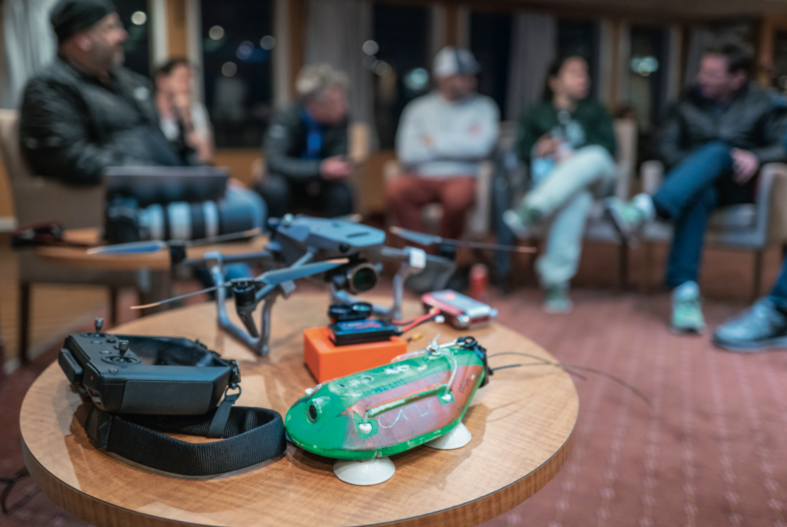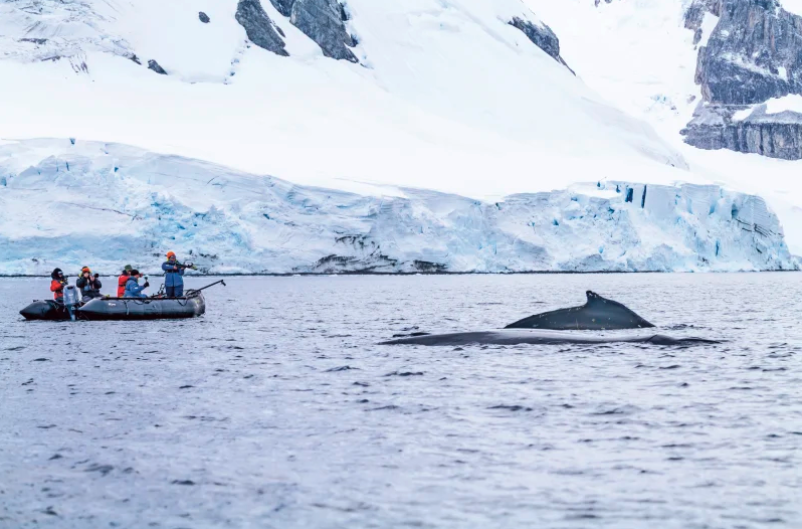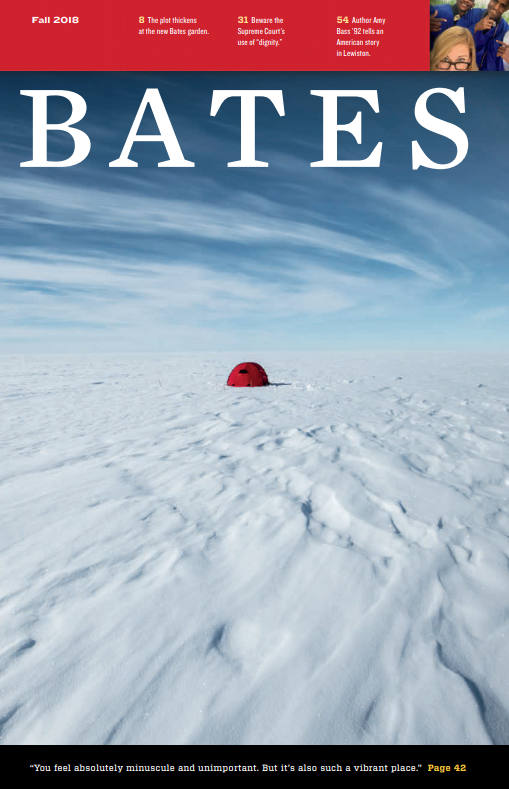In the News
BTBEL Lab
Antarctic Krill Fishing
How the latest tech is shaping the future of whale conservation
June 5, 2023
In this recent Science Focus article, James explains how our research team employs different tools to collect data in the Antarctic during each field season. His explanations of our drones, tags, and biopsy equipment are spot on. Click the picture on the left to access the PDF.
How much longer will Antarctic be a place of solace for whales?
May 15, 2023
Climate change is hitting the Antarctic Peninsula especially hard. It's one of the fastest warming regions of the planet. We're losing sea ice, which will most likely affect the availability of krill – whales' main food source down here. Commercial fisheries are quite literally taking food from the whales' mouths. What's going to happen?
Can Whales Save the Planet?
April 20, 2023
Our team has just finished an incredible field season in the Antarctic. We collected several hundred biopsies of whale tissue, paired many of these with measurable images of body condition using drones, placed tags on several animals, and conducted exposure experiments for a new study on the impacts of tourism on whale behavior. A film team from NowThis Earth joined one of our teams on an Intrepid Travel ship to tell our story.
Using AI to Listen to Whales
November 3, 2022
In an exciting partnership with the Earth Species Project, we're working on our ability to understand other species, like whales. There could be a number of benefits, and challenges, involved with decoding the language of other animals. Check out this panel discussion led by Aza Raskin from the World Economic Forum held in San Francisco on October 25, 2022.
Monitoring Whales from Space
Scientists have found that studying high-resolution images of whales from space is a feasible way to estimate their populations. A team, led by British Antarctic Survey (BAS; press release here), compared satellite images to data collected from traditional ship-based surveys. This study is a big step towards developing a cost-effective method to study whales in remote and inaccessible places. Check out the full scientific article published in Scientific Reports here.
Blue Whale Hearts May Beat Only Twice a Minute During a Dive
Blue whales have a flair for paradox. They live in water but breathe air. They’re enormous — the biggest creatures that have ever lived, as far as anyone knows — but subsist almost entirely on tiny krill. And as new research reveals, even the animal’s dunk tank-size heart jumps between extremes. Find the full story here.
Remarkable video shows how minke whale feeds
In a collaboration with WWF, Dr. Ari friedlaender led a team in Antarctica and attached a camera to an Antarctic minke whale. In doing so they captured incredible evidence of how these whales feed. The camera – one of three “whale cams” funded by WWF-Australia – is part of efforts by scientists to better protect whale feeding areas in Antarctica.
2018: A Year In Stunning Conservation Photography
Take a look at just a few of WWF's favorite photographs from 2018, including an Antarctic collaboration between WWF and the Friedlaender BTBEL lab back in Santa Cruz. The full article can be found on WWF online here.
How humpback whales made a global comback
"As international whaling ramped up around the turn of the 20th century so did efforts by governments, activists, and the public to stop the practice. By 2016, more than half of the species' 14 population segments were no longer considered endangered." Check out the article which features BTBEL lab PhD student Logan Pallin's work on pregnancy in Southern Ocean Humpbacks.
Humpback Whales Rebound
Nineteenth century commercial whaling killed the vast majority of whales, but some species are coming back, especially humpbacks. Melting Antarctic ice has led to an abundance of krill, and with all that food humpback whales are thriving with high rates of pregnancy. University of California – Santa Cruz Researcher Ari Friedlaender tells Host Steve Curwood the comeback should be celebrated as a conservation victory, but there are questions about how long the krill boom might last.
Marine scientist-in-training camp slate for summer in Monterey Bay area
SANTA CRUZ >> High school students will get a chance this summer to shadow and assist top marine scientists, as part of a new field study program centered at the Monterey Bay Marine Sanctuary Exploration Center.
Students will board research boats, to identify and assist in tagging whales and place listening sensors in open water.
Antarctica’s Waters May Soon Harbor a Boom of Baby Humpback Whales
From 2010 to 2016, researchers collected skin and blubber samples from 577 humpbacks using a crossbow with modified darts. By sequencing DNA, the team determined that that population included a total of 239 males and 268 females. Higher levels of the hormone progesterone in the blubber showed that an average of 63.5 percent of those females were pregnant when sampled. But the story is in how those numbers changed, not the average.
Beneath the Ice
A few miles off the coast of the rapidly warming Antarctic Peninsula, scientists are getting their first-ever detailed look at one of the most mysterious mammals on the planet, minke whales.
Smaller cousins of the mammoth blue whale, the elusive minkes have remained mostly out of reach in the deep fjords of the icy Antarctic. It wasn’t until earlier this month that a team of scientists using an array of drones, suction-cap tags, and whale-mounted video cameras uncovered some basic facts about the species, such as their average size and how they moved. They discovered that minkes, long thought to be loners, are outgoing and social. They found out that minkes had spots.
How to Attach a Video Camera to a Humpback Whale
“You’ve just put an instrument on the biggest animal that’s ever lived, and you got the most incredible view while doing it,” said Ari Friedlaender, a marine ecologist at Oregon State University who says he has become so proficient at tagging whales that he doesn’t even notice the boat rocking. “Afterwards there’s kind of an adrenaline rush.”
Life as a whale: a humpback's view of the Antarctic- in pictures
‘Whale cams’ and digital tags attached to minkes and humpbacks allow scientists to go below the surface of the Antarctic ocean and experience a day in a life of these ocean giants. The data will help them to understand the animals’ behaviour and the impacts of climate change.
An Antarctic ecologist says humpback whales will be fine in 2017! Everything else, not so much
The consequences of climate change in the poles can be a hard sell for disinterested Earth residents. Sympathy for polar bears afloat shrinking ice platforms to the north and dwindling penguin populations to the south only goes so far, and dense academic papers on the other end of the spectrum remain impenetrable for those without marine-biology degrees.
A Rare Look at the Disappearing World of Antarctica's Whales
CIERVA COVE, ANTARCTICA Ari Friedlaender kneels at the front of our inflatable boat as it bobs on the ocean.
He holds a rifle, with two metal harpoons protruding from its muzzle. His gaze is fixed a few feet ahead, where something big stirs just beneath the surface. “OK, put it in neutral,” he says to the driver. Our boat drifts closer.
Ari Friedlaender's Whale Tagging Research Featured in Nat Geo Documentary
In March 2016, Ari Friedlaender was joined by a National Geographic film crew in Antarctica. The incredible footage premiered on Tuesday, November 15, 2016 on the National Geographic channel. Dr. Friedlaender’s research is be featured in all six episodes of the new documentary series, Continent 7.
New App Features Ari Friedlaender's Antarctic Research
WWF has created a unique multi-media and interactive app that engages people about the current state of Antarctica and the Southern Ocean. It is replete with sections dedicated to sharing stories and reports on Antarctic science and conservation in action. One section, "whale research above and below the ice," tells about Ari Friedlaender’s work in Antarctica to uncover some of the mysteries surrounding minke whales and how these poorly known whales survive in a changing environment.
What Whales Do at Night
In waters off the West Antarctic Peninsula, Ari Friedlaender found that humpback whales fed exclusively at night when the krill migrated vertically into shallower water and became an easier catch. During the day, when krill were deeper and harder to access, the humpbacks spent more time resting at the surface.
News Archive
To see more "In the News" articles, click here.

















